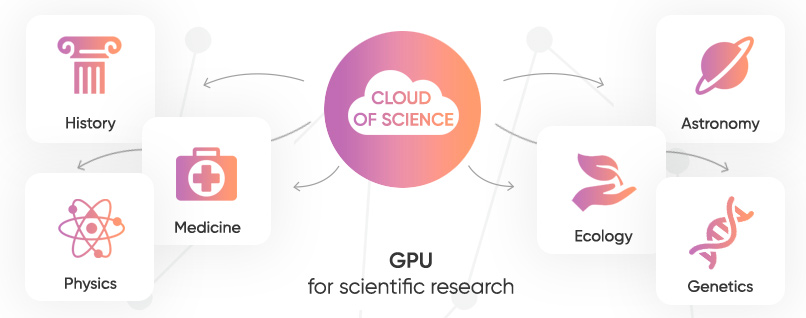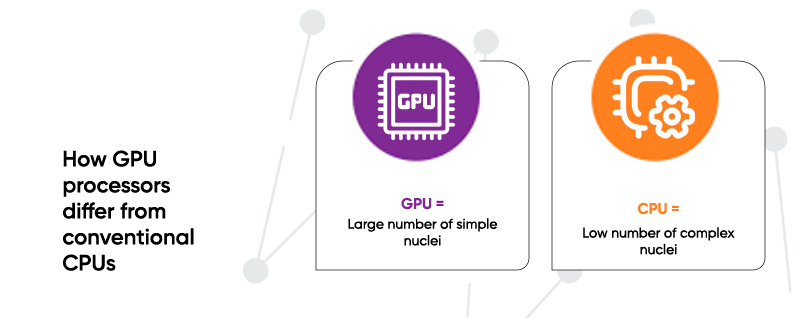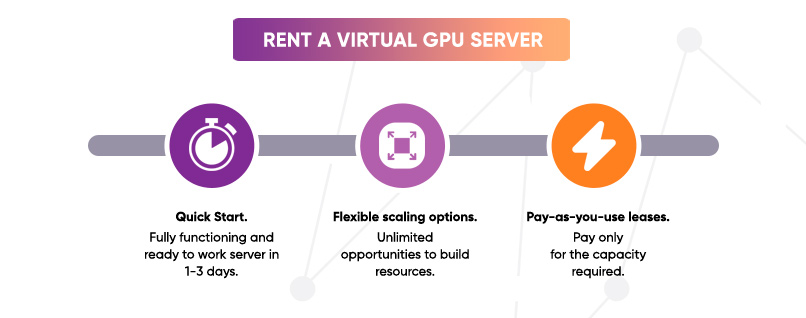Contents
GPU servers are used for high-performance computing in a wide range of industries: from cryptocurrency mining to machine learning. It is not surprising that almost all major European service providers offer commercial companies and enterprises to rent hardware with GPU processors, as well as provide design, assembly and maintenance services for servers with graphics chips.
The main advantage of GPU processors is that they are able to efficiently process parallel data streams in large volumes, whereas CPUs are designed for sequential execution of tasks. Initially GPUs were used for “heavy” graphics processing, but later the scope of their application was significantly expanded and now graphics accelerators are much more often used for general computing.
The world’s leading hardware manufacturers take market demand into account and develop special GPU chips that are best optimized for specific tasks of parallel data processing, for example, for training neural networks and logical inference. However, servers with graphics processors are still the best solution also in those cases when it is necessary to solve tasks related to video rendering, graphics processing, analysis and modeling based on huge databases. That is why, when building a server for a particular project, it is important not only to consider business requirements, but also to follow the recommendations of manufacturers.
When business needs dedicated GPU server
In many industries, high-performance computing is not just an auxiliary tool, but the only way to compete effectively in the marketplace. Both small commercial companies and large corporations use GPU servers to organize their business processes. Along with the development of technology, new areas of application are emerging.
GPU for artificial intelligence
The basic principle of neural network training is to configure internal parameters using a large number of mathematical operations based on a large amount of incoming data. GPU accelerators are best suited for this task.
Graphics chips are most effective when processing images and language models. Analysis and classification of visual data, for example, are needed for the development of smart security systems and for car manufacturers to create automatic control systems. Speech recognition technologies are actively used in the organization of online services and in the development of WEB applications. Progress in the field of artificial intelligence has triggered a huge demand for GPU servers for machine learning (ML), deep learning (DL) and logical inference.
GPU for finance and blockchain
In finance, GPU servers are used to analyze and make predictions based on large amounts of data. Complex algorithms are used to identify mechanisms and patterns that help make informed financial decisions. High-performance computing is in demand in stock trading, as well as for ensuring the security of financial transactions. In the world of cryptocurrencies, servers with graphics chips are used for mining and adding information to the blockchain.
GPU for scientific research
In fields such as physics, astronomy, and environmental science, huge amounts of data are generated that are best handled by graphics chips. Global system simulation and modeling processes require complex mathematical formulas for millions of data points. GPU processors perform these operations for each point simultaneously, allowing scientists to get simulation results much faster.
GPU for medicine and biotechnology
High-performance computing is essential for modeling biological structures and calculating reactions in them. Servers with GPU processors help to compare DNA sequences, predict diseases, and find effective treatments. Graphics chips allow scientists to process genomic data quickly and accurately. The results of genome analysis become the basis for more effective cancer research, enabling more effective drugs to be brought to market.

GPU for graphics and rendering
Processing 3D graphics, creating detailed and realistic images is another application for servers with GPU processors. Applications such as AutoCAD, Adobe Illustrator and Photoshop need GPUs to improve performance. GPU chips help to correct images and display images in real time. Rendering technologies (the step-by-step creation of a three-dimensional image) would not be possible without the use of GPUs.
GPU for architecture, construction and engineering
Servers with graphics processors are necessary when designing 3D volumetric models containing thousands of interconnected elements. Complex graphics processing is used in modeling architectural structures and industrial objects. It is always in demand in architectural and design offices. For a long time already creation of airplanes, helicopters and ships involves 3D design. GPU servers help engineers to work together even in remote access conditions.
GPU for gaming and VR
It’s no secret that video games have been the main catalyst for the development of computer technology and GPU processors in particular. Graphics in games is becoming more and more complex every year, and to create realistic images you need to determine the position and color of each pixel on the screen. It is graphics chips that do the calculations, create realistic movements and interactions, allowing gamers to immerse themselves in fantastic worlds drawn with amazing accuracy.
For virtual reality, the computational requirements are even higher. Creating a stereoscopic 3D effect requires showing the same scene from two different perspectives at the same time, which doubles the load on GPU processors. Virtual Reality applications can only be utilized with high-performance computing using GPU.
CPU vs. GPU. How GPU processors differ from conventional CPUs
The most important element of a GPU processor is its cores, which are originally designed to work in parallel. GPU processor cores are simpler than CPUs, but there are much more of them. For example, one of the most powerful CPUs AMD EPYC 9554 has 64 cores, and the advanced GPU processor NVIDIA H100 contains 12592 CUDA cores.

GPU cores can be divided into several categories:
- CUDA cores are general-purpose cores designed for parallel computing. They are used in NVIDIA processors, in AMD chips the same role is assigned to stream processors, and in Intel – to shader cores
- Tensor cores are a special development of NVIDIA. They are designed for matrix multiplication and were specifically created to work with artificial intelligence. Ampere architecture uses 3rd generation tensor cores, which are almost 20 times faster than 2nd generation computing units.
- Ray tracing cores are designed for real-time audio and video processing by rendering. They can also be used to accelerate graphics in video games and other applications that use 3D or VR. The essence of rendering is to simulate the processes of light reflection in space when passing through various materials. Ray tracing technology has been used before, but only recently has it been possible to implement it for real-time rendering of moving graphics. NVIDIA’s ray tracing cores are called RT and AMD’s are called RAY accelerators.
Some GPUs may have 3 kinds of cores at once, but their number will not be the same. In some chips there are no ray tracing cores, but the number of tensor cores is increased.
It is easy to conclude that certain models of GPUs are optimized by manufacturers for a specific type of tasks. A few GPU chips from NVIDIA can be given as an example for a clear comparison.
| GPU processor | CUDA cores | Tensor cores | RT cores |
| H100 | 14592 | 456 | – |
| RTX 4090 | 16384 | 512 | 128 |
| A 6000 Ada | 18176 | 568 | 142 |
How to select a dedicated GPU server for your business project
Write us a message to get additional information.
or book a free consultation
How to select components for GPU server
Servers with graphics accelerators have approximately the same architecture and set of components as a conventional server, but their tasks are solved in the context of large amounts of data and high computing power. This is the reason why hardware with high speed and performance indicators is selected to organize GPU servers.
CPU
CPU is often referred to as the “brain” of the server, responsible for implementation of all major tasks and interactions. It controls the work of the operating system, regulates the interaction of hardware parts, and performs general calculations. The best CISC-based x86 CPUs on the market so far are Intel® Xeon® 5th generation and AMD EPYC™ 9004. Any of these processors are suitable if you need great performance combined with a robust ecosystem.
GPU
GPUs are selected depending on the GPU server’s field of use and the business requirements for a particular project. If maximum processing power is required for training neural networks, NVIDIA HGX™ H100 and AMD’s GPU Instinct™ MI300X accelerators are the best options for now. In cases where you don’t require maximum performance, you can use NVIDIA L4, NVIDIA L40, or NVIDIA L40S graphics chips.
For rendering and gaming, NVIDIA RTX 3090 or RTX 4090 graphics chips are recommended, as well as NVIDIA RTX A5000.
RAM and storage
So far, the best type of RAM remains DDR5 SDRAM, the fifth generation of dual bit rate RAM. However, for any GPU server, a single memory module will not be enough anyway. Some server form factors contain up to 48 DIMM slots. The total RAM capacity for industrial solutions can be up to 1024 GB RAM.
The total SSD capacity is also selected based on the technical requirements of the project. When building GPU servers, NVME SSDs are almost always used. These are characterized by the highest transfer rates and lowest latency.
Form factor
Form factor defines the amount of rack space a server will occupy. The form factor is measured in mounting units called units (U). The width of the server is always the same, but the height will directly depend on the number of U, because the units are placed one above the other. The exception is the Tower form factor servers, which resemble a classic personal computer system unit.
When building a GPU server engineers usually use form factors ranging from 1 to 8 U in height. One U on average contains up to 4 GPUs. GPU chips are characterized by high heat dissipation, so the more densely located accelerators, the more complex the cooling system. When designing a server, you should also remember that the more U provided by the form factor, the more expensive it will cost to rent a rack in the data center.
Dedicated GPU server or GPU VPS server?
Large European service providers offer not only physical servers for rent, but also services for organizing virtual GPU servers. Each option has its own advantages and disadvantages.
Renting a dedicated GPU server allows the client to get full control over the hardware and software, which in some cases is a critical requirement. In addition, renting service provider’s hardware is more profitable in the long run. Some European service providers offer dedicated GPU servers for leasing, which significantly reduces the financial burden on a business project.
The main disadvantage of a dedicated server with a graphics processor is the need to independently maintain and repair the hardware, the obligation to deal with software licensing issues. In addition, it is much more difficult to scale the resources of a dedicated server than a virtual one.
Renting a virtual GPU server saves the client from the need to maintain and repair hardware, update software and solve licensing issues. There are other important advantages as well, namely:
- Quick start. Setting up and launching a virtual server even in a custom configuration takes minimum time. The client gets a fully functioning and turnkey server in 1-3 days. The start time of pre-prepared configurations can be hours and even minutes.
- Flexible scalability. Virtual server parameters can be quickly changed, such as adding memory or increasing processing power, if necessary. Today’s cloud technologies provide almost unlimited opportunities to increase the resources of virtual GPU servers.
- “Pay-as-you-use” lease option. The client can pay only for the capacity they need and protect themselves from having to pay for resources that are reserved but for some reason unused.

The main disadvantage of using a virtual server is its relatively high cost. The market situation shows that for the majority of commercial companies, it is the financial criterion that is decisive. It is much easier to rent a high-performance GPU server from a service provider than to pay a high price for a cloud solution.
Consultant on hosting solutions, network and cloud technologies A 30-minute consultation to determine which dedicated GPU server you need for your business project.
How to save on GPU server rental and hosting in Tier 3 data center
High-performance GPUs are very expensive hardware. For example, the market value of an NVIDIA HGX™ H100 graphics accelerator is around €40,000. In some cases, multiple GPU chips may be required. Thus, optimizing costs at the development and launch stage of a project is relevant even for large companies.
A convenient solution is to purchase a GPU server via leasing. Usually a contract with a service provider is signed for a period of 2 to 5 years, and the amount of the first payment is only 2-3% of the cost of the hardware. For example, if the total cost of a GPU server is 40,000€, the first payment will be only 800€. In addition, leasing payments can be formalized as expenses, which reduces the tax burden.
There are other services that can help simplify GPU server maintenance and reduce rental costs.
- Colocation. The service of hosting hardware in Tier 3 class data centers is in high demand among companies for which the security criterion is of critical importance. Large data centers are equipped with state-of-the-art fire safety systems and redundant air conditioning equipment. The data centers have 24-hour security officers on duty, and access to server rooms is possible only by biometric data.
- GPU server migration and relocation to another data center. Some service providers offer this service as a free bonus if the company has signed a contract for colocation of hardware in the data center. Transportation services and hardware connection at the new location may also be free of charge.
- Server maintenance by specialists of the service provider. GPU server maintenance by provider saves the business from the need to independently solve the issues of repair, licensing, correct operation of hardware and software. The client receives regular reporting on the server and software operation, and the probability of incidents is significantly reduced.
- Post-warranty service on a subscription basis. Some service providers are ready to replace failed components free of charge on condition that the client pays a monthly subscription fee. The cost of this service is from €30 per month, but the final cost directly depends on the GPU server configuration.
- Free Internet with channel width up to 100 Mb. Another service that can be received as a bonus if you sign a contract for GPU server rental or hardware hosting in the data center.
When signing a contract with a service provider, it is important to pay attention to the quality of the technical support service. If the support team considers requests only via e-mail and does not respond to requests promptly, this is a serious reason to refuse to cooperate.
A good advantage is the ability to communicate with support specialists via messengers. Requests should be considered promptly, the stability of the GPU server and the success of the business project as a whole depend on it.
If you need help with selecting a GPU server configuration or information on how to organize IT infrastructure for a specific business project, sign up for a free 30-minute online consultation with our portal specialists.
Article author Olga Boujanova Consultant on hosting solutions, network and cloud technologies